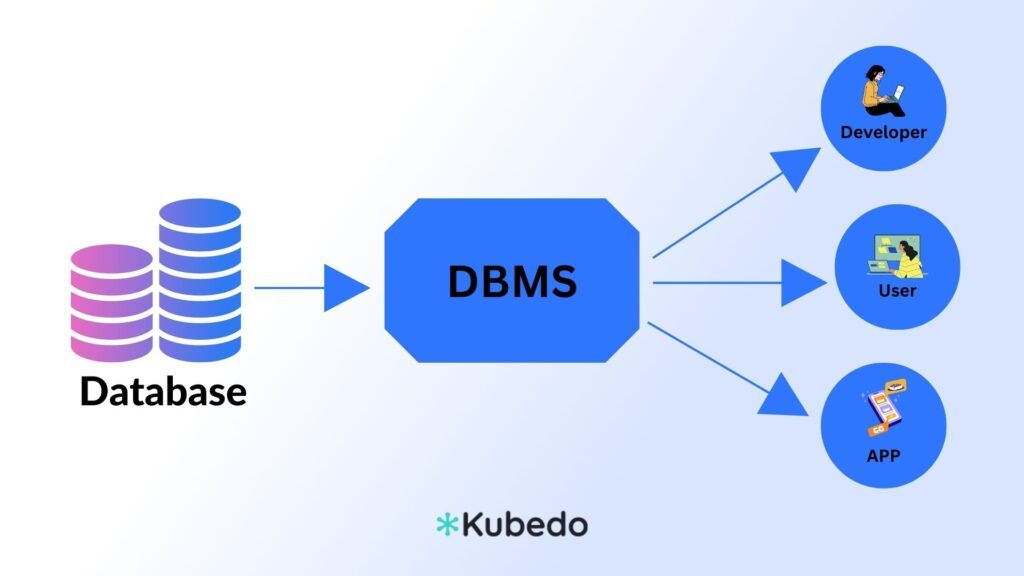What is DBMS?
DBMS, or Database Management System, is software that allows users to create, manage, and manipulate databases. It provides an interface to interact with the database and handles tasks such as data storage, retrieval, modification, and deletion. The main purpose of a DBMS is to provide an organized, efficient, and secure way to store and retrieve data, making it a crucial component in modern software applications and information systems.
Key features and reasons why DBMS is important:
- Data Organization: DBMS helps in organizing data into tables, rows, and columns, providing a structured way to store information. This structure allows for efficient data retrieval and reduces data duplication.
- Data Integrity: A DBMS ensures data integrity by enforcing data constraints and validation rules. It prevents inconsistent or incorrect data from being entered into the database.
- Data Security: DBMS allows access control and permissions to be defined for different users and roles. It ensures that only authorized users can access and modify data, protecting sensitive information from unauthorized access.
- Data Sharing: Multiple users can access the same database concurrently through a DBMS, facilitating data sharing and collaboration among different applications and users.
- Data Consistency: A DBMS ensures data consistency by providing features like transactions, which allow a series of related operations to be treated as a single unit. This guarantees that either all operations in a transaction are completed successfully, or none of them are applied.
- Data Backup and Recovery: DBMS provides mechanisms for data backup and recovery, allowing organizations to safeguard their data against accidental loss or corruption.
- Scalability: DBMS systems are designed to handle large amounts of data and can scale to accommodate increasing data volumes as the application grows.
- Data Independence: DBMS provides a layer of abstraction between the application and the underlying physical storage, allowing applications to work with logical representations of data without needing to worry about the physical implementation details.
- Data Querying: DBMS provides a powerful query language (e.g., SQL – Structured Query Language) that enables users to extract specific information from the database efficiently.
- Reduced Data Redundancy: By centralizing data in a database, DBMS eliminates data redundancy, which leads to a more efficient use of storage and reduces the chances of data inconsistency.
Database vs DBHS
Distinguishing between a database and a DBMS (Database Management System) is crucial for understanding their distinct roles.
A database serves as a structured repository where data is stored in tables, each containing rows and columns representing records and attributes.
In contrast, a DBMS is the software that enables efficient interaction with the data. It provides tools for creating, managing, and manipulating databases, ensuring data integrity, security, and optimized query processing.
While the database holds the actual data, the DBMS acts as the intermediary, facilitating controlled access and seamless manipulation, making them essential components for effective data management in modern applications.

DBMS Components
A DBMS (Database Management System) consists of various components that work together to manage databases efficiently and provide access to data for users and applications. The major components of a DBMS include:
- Database: The central component of a DBMS is the database itself. It is a collection of structured data that is organized into tables, which contain rows and columns. The database stores all the data required for a particular application or set of applications.
- Data Definition Language (DDL): The DDL is a part of the DBMS that allows users or administrators to define the structure of the database. It includes commands to create, modify, and delete database objects such as tables, views, indexes, and constraints.
- Data Manipulation Language (DML): The DML enables users to interact with the data stored in the database. It provides commands to insert, update, delete, and retrieve data from the database. The most common DML is SQL (Structured Query Language).
- Data Query Language (DQL): DQL is a subset of DML that specifically deals with querying the database to retrieve information. It allows users to specify what data they want to retrieve and under which conditions. SQL also supports DQL commands, such as SELECT.
- Data Administration: This component is responsible for managing the overall database system. It includes tasks like database backup and recovery, data security and access control, performance tuning, and user management.
- Data Integrity and Constraint Management: DBMS enforces data integrity by allowing users to define constraints on the data. Constraints ensure that the data entered into the database follows predefined rules, maintaining data consistency and accuracy.
- Query Optimizer: The query optimizer is a critical component that analyzes user queries and decides on the most efficient way to execute them. It aims to minimize the response time by selecting the best execution plan for a given query.
- Transaction Management: Transactions are sets of related database operations that need to be executed as a single unit. The transaction management component ensures that transactions are executed in an all-or-nothing manner, meaning either all operations are completed successfully, or none are applied.
- Concurrency Control: In multi-user environments, where multiple users may access the database concurrently, the concurrency control component ensures that data remains consistent and avoids conflicts that may arise from simultaneous data access.
- Storage Management: The storage management component is responsible for efficiently storing data on disk and retrieving it when needed. It handles tasks like data storage allocation, file organization, indexing, and buffering.
These components work together to provide an efficient and secure way to manage data in a DBMS. They enable users and applications to interact with the data effectively while maintaining data integrity and security.
RDBMS VS. DBMS
All RDBMSs are DBMSs, but not all DBMSs are RDBMSs. RDBMS is a specific type of DBMS that follows the relational model, providing a standardized and efficient way to manage structured data with well-defined relationships. Other DBMSs can handle different data models and structures, catering to diverse data management needs.
RDBMS (Relational Database Management System) and DBMS (Database Management System) are related concepts, but they have some key differences:
| DBMS | RDBMS |
| Data Organization: A DBMS is a general term for software that manages databases. It can handle various types of data storage and retrieval mechanisms, including hierarchical, network, object-oriented, and relational models. | Data Organization: An RDBMS is a specific type of DBMS that manages databases based on the relational model. In an RDBMS, data is organized into tables with rows representing records and columns representing attributes. |
| Data Structure: In a general DBMS, the data can be structured in various ways, depending on the data model used. It may or may not adhere to the relational model’s principles. | Data Structure: An RDBMS strictly adheres to the principles of the relational model, which includes organizing data into tables and enforcing relationships between tables using keys (primary keys and foreign keys). |
| Data Integrity: Data integrity enforcement may vary depending on the specific DBMS and data model used. Some DBMSs offer data integrity features, while others may not have as robust integrity checks. | Data Integrity: RDBMS systems have strong support for data integrity. They enforce constraints like uniqueness, foreign key references, and check constraints to ensure data accuracy and consistency. |
| Query Language: The query language supported by a DBMS can vary. Some may have their own proprietary query language, while others might support SQL or other standardized query languages. | Query Language: RDBMS systems commonly use SQL (Structured Query Language) as the standard query language to interact with the database. |
| Schema Changes: In some DBMSs, schema changes (e.g., adding or removing attributes) can be complex and may require significant effort. | Schema Changes: RDBMS systems generally have more straightforward schema modification capabilities, as they follow the relational model’s well-defined structure. |
| Flexibility: DBMSs can be more flexible in terms of data modeling, which is advantageous when dealing with various types of data and complex relationships. | Flexibility: RDBMS is particularly well-suited for structured data with well-defined relationships, making it a good choice for applications that require data consistency and standardization. |
Types of Database Management Systems
There are several types of Database Management Systems (DBMS) based on different data models and structures.
The followings are just some of the main types of DBMSs. Each type has its own strengths and weaknesses, making them suitable for different applications and use cases. The choice of DBMS depends on factors such as the nature of the data, performance requirements, scalability needs, and the specific features required for the application.
- Relational Database Management System (RDBMS): This is one of the most common types of DBMS. Data is stored in tables with rows and columns, and relationships between tables are established using keys. Popular examples include MySQL, PostgreSQL, Microsoft SQL Server, and Oracle Database.
- NoSQL Database Management System: NoSQL databases are designed to handle large volumes of unstructured or semi-structured data. They don’t follow the traditional relational model and offer flexibility and scalability. Types of NoSQL databases include document databases (MongoDB), key-value stores (Redis), column-family stores (Cassandra), and graph databases (Neo4j).
- Hierarchical Database Management System: Data is organized in a tree-like structure, where each record has a parent-child relationship. This model is not as widely used as it once was but can still be found in certain specialized applications.
- Network Database Management System: Similar to hierarchical databases but with more flexible relationships. Data is organized as a graph, allowing records to have multiple parent and child records. This model is also less common nowadays.
- Object-Oriented Database Management System (OODBMS): These systems store data in objects, which include data and methods that can operate on that data. They are designed to handle complex data structures and are often used in object-oriented programming environments.
- NewSQL Database Management System: These systems aim to combine the benefits of traditional relational databases with the scalability and performance improvements of NoSQL databases. They provide features like distributed processing and horizontal scaling while maintaining ACID compliance.
- In-Memory Database Management System: Data is stored and manipulated in main memory (RAM) instead of on disk. This leads to faster data access and retrieval but can be limited by the available memory.
- Time-Series Database Management System: Designed to handle time-series data, which consists of data points collected at specific time intervals. They are often used in applications like monitoring, IoT, and financial analysis.
- Spatial Database Management System: These databases are optimized for storing and querying spatial data, such as geographic information system (GIS) data.
- Cloud Database Management System: These databases are designed to run in cloud environments, offering scalability, elasticity, and easy deployment options. Examples include Amazon Aurora, Google Cloud Spanner, and Microsoft Azure SQL Database.
Benefits of Using a DBMS
A Database Management System (DBMS) offers a host of advantages that significantly enhance data management across diverse applications. One of its primary benefits is data centralization, as a DBMS provides a centralized repository where information is stored. This eliminates the complexities of managing multiple copies of data across various locations, leading to consistency and a reduction in data redundancy.
Moreover, data integrity is a key strength of DBMS. It enforces the adherence of data to predefined constraints and rules, preventing the input of invalid or inconsistent data. Security features are robust within DBMS systems, encompassing user authentication, access controls, and encryption. This ensures that only authorized personnel can access and modify data, thereby safeguarding data privacy and security.
DBMS enables effective data sharing and collaboration, allowing multiple users and applications to simultaneously access the same database. This not only fosters real-time access to current information but also facilitates collaborative efforts. Data independence is another advantage, as applications can interact with data without needing knowledge of its physical structure on storage devices.
Efficient data retrieval is a hallmark of DBMS, achieved through query languages such as SQL. Techniques like indexing expedite data retrieval, even from extensive datasets. By centralizing data, DBMS minimizes redundancy, reducing storage requirements and the likelihood of inconsistencies. The system also supports backup and recovery mechanisms, safeguarding against data loss.
Scalability is a hallmark of many DBMSs, permitting expansion to accommodate burgeoning data volumes and user demands. Concurrency control ensures data consistency in multi-user settings. Flexibility is intrinsic to DBMSs, catering to various data models like relational, NoSQL, and object-oriented, among others. This adaptability makes them versatile solutions for diverse business needs. Ultimately, DBMS not only streamlines data management but also empowers analysis, reporting, and decision-making processes, making it a cornerstone of effective information management.
Challenges of Using a DBMS
While Database Management Systems (DBMS) offer numerous benefits, they also come with their share of challenges that organizations need to address. One major challenge is ensuring data security and privacy. As DBMSs store sensitive and critical data, protecting it from unauthorized access, data breaches, and cyber threats is paramount. This requires robust security measures, regular updates, and diligent monitoring.
Another significant challenge is data consistency and integrity. In multi-user environments, concurrent access to data can lead to conflicts and inconsistencies. Implementing effective concurrency control mechanisms becomes essential to maintain data accuracy and prevent data corruption.
Scalability is a recurring concern as data volumes grow exponentially. Ensuring that the DBMS can handle increased loads while maintaining performance levels requires careful planning and often necessitates database tuning or even migrating to more scalable solutions.
Data migration and system upgrades present their own challenges. Migrating data from one DBMS to another or upgrading to a new version can be complex and time-consuming. Compatibility issues, data loss, and application downtime are potential risks that need to be managed.
Vendor lock-in is another challenge, particularly with proprietary DBMS solutions. Organizations may become dependent on a specific vendor’s technology, making it difficult to switch to other systems without significant effort and cost.
Backup and recovery strategies are critical but can be challenging to implement effectively. Ensuring that backups are up-to-date, reliable, and capable of restoring data in case of disasters or failures is essential for business continuity.
Data governance and compliance with regulations like GDPR, HIPAA, and others can be demanding. Organizations need to ensure that data is managed in accordance with legal requirements, which involves policies, audits, and access controls.
Furthermore, DBMS administrators need to be well-trained and experienced to manage these systems effectively. Skilled personnel are required for tasks like performance optimization, security management, and resolving issues.
Conclusion
Database Management Systems (DBMS) are the cornerstone of modern data management, ensuring organized, secure, and efficient handling of data. With diverse types and powerful features, DBMSs play a crucial role in supporting applications, fostering collaboration, and enabling data-driven decision-making. While challenges exist, understanding and effectively addressing them empowers organizations to harness the full potential of DBMS technology.


